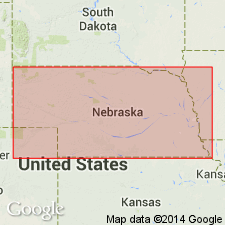
- Usage in publication:
-
- Stoner limestone bed
- Modifications:
-
- Original reference
- Dominant lithology:
-
- Limestone
- Shale
- AAPG geologic province:
-
- Nemaha anticline
Summary:
Pg. 11, 26, 27, 31, 33, 34, 36, 37. Louisville limestone is preoccupied hence Stoner limestone is proposed for this unit to include also Kiewitz shale and so-called Du Bois limestone. Consists of bluish, light gray to buff, dense, slabby, massive or bedded, fossiliferous, somewhat argillaceous limestone, and greenish bluish gray, argillaceous, calcareous, fossiliferous shale. Thickness 14 to 16 feet 8 inches. Underlies Rock Lake shale and overlies Eudora shale. Described from measured sections along Platte River, Cass Co., southeastern Nebraska. Has been traced into Missouri and Kansas. Age is Pennsylvanian.
Type locality: on Stoner farm, located northwest of South Bend, Cass Co., southeastern NE.
Source: US geologic names lexicon (USGS Bull. 896, p. 2069); GNC KS-NE Pennsylvanian Corr. Chart, sheet 1, Oct. 1936; supplemental information from GNU records (USGS DDS-6; Denver GNULEX).
For more information, please contact Nancy Stamm, Geologic Names Committee Secretary.
Asterisk (*) indicates published by U.S. Geological Survey authors.
"No current usage" (†) implies that a name has been abandoned or has fallen into disuse. Former usage and, if known, replacement name given in parentheses ( ).
Slash (/) indicates name conflicts with nomenclatural guidelines (CSN, 1933; ACSN, 1961, 1970; NACSN, 1983, 2005, 2021). May be explained within brackets ([ ]).

